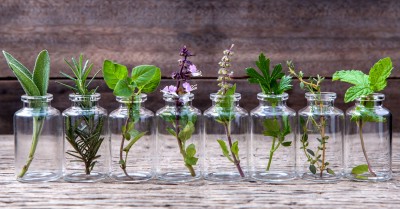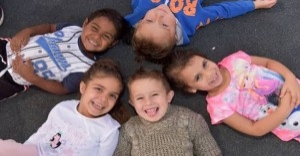Creating your very own herb garden within the learning environment is a fantastic method for children to learn about gardening. The majority of herbs are simple to grow and require minimal care to thrive. Herbs are excellent first plantings for children. The following article lists herbs that only need water to grow all year long.
Children like discovering and exploring the natural world. A fragrant herb garden offers a variety of intriguing scents that even a three-year-old will find fascinating.
The majority of the herbs that young children may eat or come into touch with on a daily basis can be unfamiliar to them. You may educate a child on the names of the various herbs and how they are used on a daily basis by creating a herb garden with them.
List Of Herbs That Only Need Water To Grow
It's simple to make an indoor herb garden in a sunny area by growing herbs in water. Food is greatly enhanced in flavour by herbs like basil, thyme, mint, and parsley, the majority of which are simple to cultivate in water. Also, it's a pest- and mess-free way to enjoy fresh herbs all year round.
The following herbs only need water to grow.
- Peppermint - To prepare herbal tea, oil, or soup, grow some peppermint in a jar and cut off some leaves. You can also just savour this fragrant herb's lovely aroma. In gloomy or partially sunny windows, peppermint thrives.
- Oregano - Fresh oregano can be added directly to soups, spaghetti sauces, and other savoury recipes. Just gently separate a few of the leaves from the stem using a pair of kitchen scissors. Keep an eye on your plant because oregano can get pretty enormous.
- Sage - Sage is a preferred herb for holistic uses because of its pleasant aroma. Additionally, sage goes well with chicken, lamb, eggs, and pineapple. Sage should be kept in moderate sunshine and doesn't require a lot of water.
- Basil - This well-known Italian herb can be used in soups and sauces and thrives in watery environments. Ensure that your basil jar receives 6 to 8 hours of direct sunlight each day.
- Stevia - Although it does best in partial sunlight, this hardy herb can also thrive in more shade. You may naturally sweeten your tea or coffee by using the leaves from this herb! The leaves can also be ground into a powder to be used as a sweetener.
- Thyme - Thyme is a herb with several uses. It will bloom, and the edible blossoms are a bonus. It can also be harvested before to flowering; the stems can then be hung to dry the leaves, and the leaves can then be removed and used in recipes. Place those jars in a window that receives plenty of sunshine since thyme requires it.
- Rosemary - This aromatic herb grows well in direct sunlight or regions with some shade. However, it will thrive in direct sunshine. Spice up your favourite chicken recipe with your growings!
- Lemon balm - The plant lemon balm can be used to prepare a herbal tea that promotes relaxation, eases gastrointestinal symptoms, and eases difficulty falling asleep. Provide this plant with a lot of sunlight.
- Chives - This member of the onion family may be grown quite easily and is a versatile ingredient. For maximum growing outcomes, make sure this herb has plenty of water and sunlight.
- Coriander - Although a little shade is OK, plenty of sunlight is preferred by cilantro.
- Lavender - Lavender can be used to relieve the symptoms of depression, headaches, and cramps, as well as to improve sleep. Make tea or oil with lavender leaves. Additionally, lavender has a wonderful scent! Bonnie Plants claims that for this herb to flourish, the sun and clean air are essential.
- Marjoram - Although it thrives in direct sunshine, this plant grows quite well indoors. You might need to exercise some patience because this herb grows a little more slowly.
-
Mint - Mint is a herb that is happy to live in water for months although it quickly sprouts roots that will fill the jar. There are many types of mint you can grow this way, and my favourites include peppermint and spearmint.
-
Lemongrass - The grassy plants have a tall upright growth and is a heat-loving herb.
There are only a few things you need to do after setting up your indoor herb garden to keep the sprigs of herbs vibrant and healthy. The water should first be changed once or twice a week. This lessens the possibility of bacteria and algae growth in the container. Find mason jars or cups to add each herb into to create a herb garden for children to explore, taste and touch. If you have a sunny spot within the indoor environment, set up the herb garden indoors. The smells themselves will be calming for the children and they can watch their herb garden grow easily.
Further Reading
Growing Vegetables Indoors In Water - Easily grow 9 kinds of vegetables in water indoors using vegetable offcuts. Children will enjoy the anticipation, curiosity and interest while growing their own vegetables.
Growing An Edible Garden For Children - One of the best ways to encourage children to grow a garden to develop a range of skills is to create an edible garden. The following provides information on how to set up and grow an edible garden for children.
References:
- Growing Herbs In Water, Savvy Gardening
- Herb Gardens For Children, Garden Know How
- Growing Herbs With Children, Kids Do Gardening
PLEASE NOTE: This is to be used as a general guideline only.



 Open ended questions cannot be responded to with one word answers such as yes or no. These types of questions enables a child to provide
Open ended questions cannot be responded to with one word answers such as yes or no. These types of questions enables a child to provide During your child’s preschool years, an important milestone begins to emerge. This is the development of pre-writing skills. Pre-writing skills are used to encourage, develop
During your child’s preschool years, an important milestone begins to emerge. This is the development of pre-writing skills. Pre-writing skills are used to encourage, develop Open ended materials enables children to play freely. They are objects that have no rules to follow, use or function. Raw materials that can be
Open ended materials enables children to play freely. They are objects that have no rules to follow, use or function. Raw materials that can be An Acknowledgment of the Country is a way of showing respect for the Traditional Owners and can be given by both non-Indigenous people and Aboriginal
An Acknowledgment of the Country is a way of showing respect for the Traditional Owners and can be given by both non-Indigenous people and Aboriginal Language plays an important role in a child’s development. It enables a child to communicate effectively with their family, learn at school, socialize with friends,
Language plays an important role in a child’s development. It enables a child to communicate effectively with their family, learn at school, socialize with friends, Like adults, children have to deal with their own stress in life. Moving house, starting a new school, preparing for a new sibling - these are
Like adults, children have to deal with their own stress in life. Moving house, starting a new school, preparing for a new sibling - these are Playdough is such a versatile material. It provides numerous benefits to children as they manipulate it, it is safe and soothing and provides children with
Playdough is such a versatile material. It provides numerous benefits to children as they manipulate it, it is safe and soothing and provides children with Teaching children about sustainability enables them to appreciate and respect the natural environment. Early childhood services can provide meaningful hand on learning experiences in order
Teaching children about sustainability enables them to appreciate and respect the natural environment. Early childhood services can provide meaningful hand on learning experiences in order Recycling is an important concept that teaches children to care for the environment. It encourages children to be responsible and show a growing appreciating for
Recycling is an important concept that teaches children to care for the environment. It encourages children to be responsible and show a growing appreciating for When children apply paint to paper, glue things together, or pound a lump of clay, they experiment with colour, shape design and texture.
When children apply paint to paper, glue things together, or pound a lump of clay, they experiment with colour, shape design and texture.



